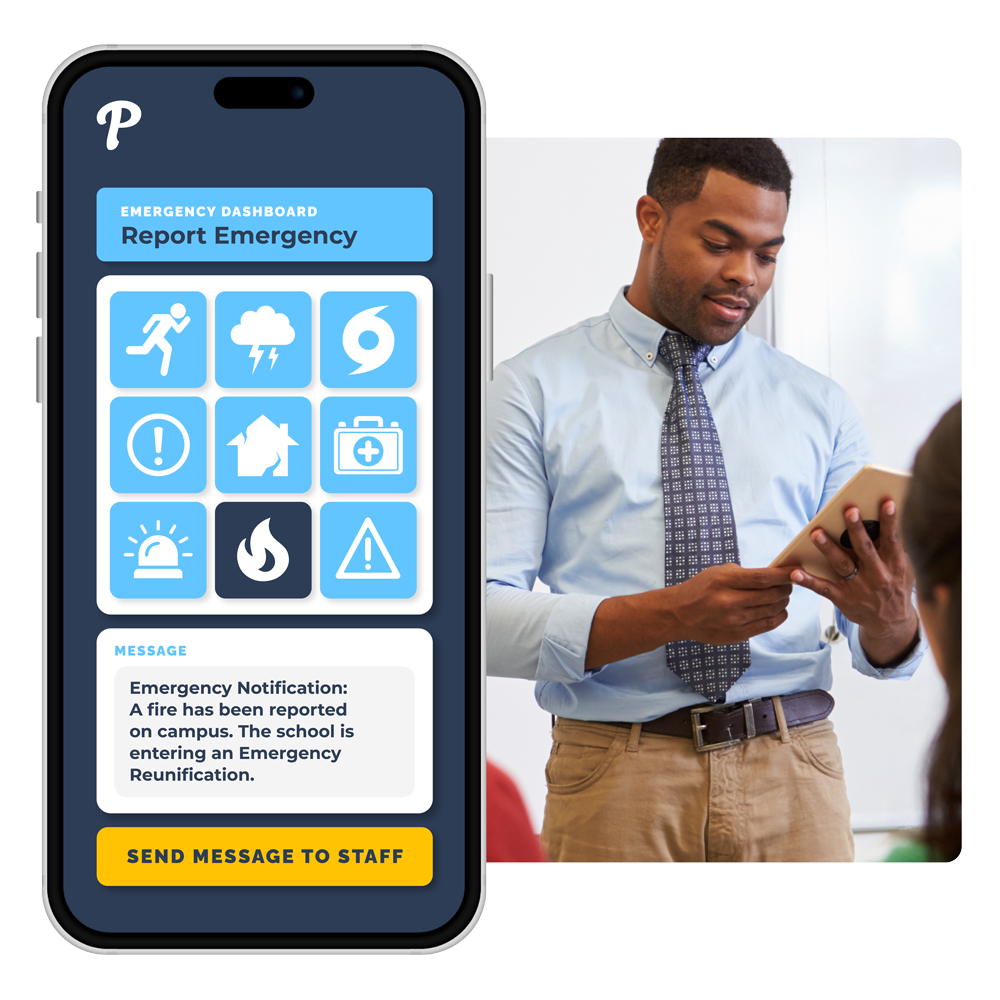In today’s K-12 school environment, where safety issues are a growing concern, having a robust emergency alert system is crucial. While more than 90% of schools have a safety management system, many lack the adequate tools to address recent safety challenges. This emphasizes the need to redefine emergency management systems, ensuring they align with the unique needs of schools and districts in our modern era.
Implementing an emergency alert system sufficient for the current K-12 school environment requires careful consideration to ensure the safety and well-being of students, staff and parents. While many companies offer tools that promise to increase safety, not all take into account the holistic approach needed to meet current school and district realities.
In this blog article, we’ll explore:
- What is a school emergency alert system
- Different types of emergency alert systems
- Key features to include in your emergency alert system
- Using state driven guidance for safety applications
- Factors to consider when choosing an emergency alert system
- How a customizable emergency alert system works
What is a School Emergency Alert System?
A school emergency alert system is a specific type of alert system designed to quickly and efficiently communicate critical information to students, staff, and parents in the event of an emergency or crisis situation within a school or educational institution. The primary goal of the system is to enhance the safety and security of everyone on the school campus.
Implementing a school emergency alert system is part of an overall strategy to enhance preparedness and response capabilities, helping to protect the well-being of students, staff, and visitors in the face of unforeseen emergencies during the school day or while present on campus.

What are the Different Types of School Emergency Alert Systems?
School emergency alert systems come in various forms, and their features may vary based on the specific needs and requirements of the school or district. Here are some common types of school emergency alert systems:
Mass Notification Systems (MNS)
These systems are designed to send out alerts and notifications to a large number of people simultaneously through multiple communication channels. MNS can include text messages, emails, phone calls, and alerts on digital platforms.
Emergency Notification Apps
Mobile applications dedicated to emergency communication can be installed on smartphones and other devices. These apps allow staff or parents to receive real-time alerts, view emergency information, and sometimes communicate directly with school authorities.
Digital Signage Systems
Some schools use digital signage displays strategically placed throughout the campus to broadcast emergency messages. These systems can provide visual alerts and instructions to a large audience.
Intercom and Public Address Systems
Traditional intercom and public address systems are still widely used in schools. These systems allow for broadcasting emergency messages through speakers placed in classrooms, hallways, and other common areas.
Automated Phone Systems
Automated phone systems can be programmed to deliver pre-recorded emergency messages to parents, staff, and students. These systems can reach a large number of individuals quickly.
Social Media and Website Alerts
Schools may use official social media accounts and websites to disseminate emergency information. Posting updates on platforms like Twitter or Facebook are used to reach a broad audience.
Emergency Lighting and Sound Systems
Some schools have installed emergency lighting and sound systems that activate during specific emergencies. These systems may include flashing lights and audible alarms to alert individuals to take immediate action.
Two-Way Radios
In addition to alerting systems, schools may use two-way radio communication for internal coordination among staff and security personnel during emergencies.
Emergency Beacons
Visual signaling devices such as emergency beacons or strobe lights may be used to attract attention and indicate the presence of an emergency.
It’s common for schools to employ a combination of these systems. The choice of systems depends on factors such as the size of the school, the specific risks and hazards in the area, and the available budget for implementing such systems. Regular training and drills are also essential to ensure that students, staff, and faculty are familiar with emergency procedures and can respond appropriately.
Key Features to Include In Your Emergency Alert System
Mass Notification
The system allows for the rapid dissemination of messages to a large number of people simultaneously. This can include alerts via text messages, emails, phone calls, and notifications through various digital platforms.
Emergency Messaging
The ability to send out specific information related to the nature of the emergency, instructions on what actions to take (e.g., lockdown procedures), and any other pertinent details.
Integration with Multiple Platforms
The system may integrate with various communication channels, including mobile devices, desktop computers, public address systems, and digital signage within the school premises.
Customization
Schools can tailor alerts based on the type of emergency, whether it be a weather-related event, lockdown situation, fire, or other threats.
Geo-Targeting
Some systems allow for the targeting of alerts to specific geographic areas within the school campus or nearby locations.
Scheduling
The ability to schedule tests and drills to ensure that the system is functioning properly and that individuals are familiar with emergency procedures.
Integration with External Emergency Services
Coordination with local emergency services and law enforcement to ensure a unified and timely response.
Monitoring and Reporting
The system may provide monitoring and reporting capabilities for administrators to track the delivery and reception of emergency messages.

Using State Driven Guidance for Safety Applications
When considering emergency alert system options, make sure to take a look at the behind the scenes of why the system was built and if it has any limitations. Unfortunately some emergency alert applications have been built to minimally address safety concerns and really only check the boxes to be applicable for safety grants. Do your own research to ensure the solution is the one that works best for your school or district and allows you to take advantage of allocated funds to help school districts. The following direct links may assist you in your research and are tailored by state.
- Arizona – Alyssa’s Law in Arizona: HB 2683 – https://www.azed.gov/ssp
Per Arizona Revised Statute 15-154, the School Safety Program is established within the department of education to support, promote and enhance safe and effective learning environments for all students by supporting the costs of placing school resource officers, juvenile probation officers, school counselors and school social workers on school campuses.
The School Safety Program is a competitive, state-funded grant that runs in three-year cycles. Arizona public schools and charters are eligible to apply. The next opportunity to apply will be spring, 2023. The grant funding will be for three school years: 2023/2024 through 2025/2026. - Florida – Alyssa’s Law in Florida: SB 70 – https://www.flsenate.gov/Session/Bill/2020/70/?Tab=BillText
Florida passed its version of Alyssa’s Law (Florida Senate Bill 70) in 2020, making it the second state to pass the legislation. The law, named for Alyssa Alhadeff, requires Florida public schools to implement a mobile panic alert system and creates guidelines and funding avenues for those systems.
The bill, which received unanimous support in the Senate, was introduced by Sen. Lauren Book. Representatives Michael Gotlieb and Dan Daley introduced a similar bill in the Florida House of Representatives (Florida House Bill 23).
- Alabama – Alabama Lieutenant Governor’s K-12 Capital Grant Program – https://ltgcapitalgrants.alabama.gov/submit
- Georgia – Georgia Emergency Management and Homeland Security Agency – https://gema.georgia.gov/
Natural, man-made and technological events are forcing Americans to change their way of thinking about securing our nation’s top investment—children. Georgia law directs GEMA/HS to provide school safety training and technical assistance to the education, emergency management and public safety communities of Georgia. - Michigan – House Bill 4241 (2023) Michigan Proposal – https://www.legislature.mi.gov/documents/2023-2024/billanalysis/House/pdf/2023-HLA-4242-38CDFDFD.pdf
Panic Alarms (Sec. 97g) Provides $6.7 million GF/GP for districts and ISDs to implement at least one panic alarm in each school building. This would provide an estimated $2,000 per school building. - New York – New York Legislation (S.7132B/A.10018) – https://www.nysenate.gov/legislation/bills/2021/S7132
Requires Schools to Consider Silent Panic Alarm Systems as Part of Safety Plans. - New Jersey – New Jersey Alyssa’s Law – https://www.nj.gov/governor/news/news/562019/20190206b.shtml
Equipping public and secondary schools with panic alarms or emergency mechanisms. Each public elementary and secondary school building shall be equipped with at least one panic alarm for use in a school security emergency including, but not limited to, a non-fire evacuation, lockdown, or active shooter situation.
- Oregon – Silent Panic Alarms in Oregon: HB 5014 – https://www.oregonlegislature.gov/senatedemocrats/Documents/230829%20Back%20to%20School.pdf
Improving School Safety (House Bill 5014, House Bill 3584)
Factors to Consider When Choosing an Emergency Alert System
Easy Design
Opt for an application used not only when there’s an occasional emergency like a power-outage or water main leak, utilize one that’s used daily for monitoring student whereabouts. This minimizes surprises during emergencies for staff and parents since they’re just as familiar with the platform being used for emergencies as the one they use daily for other school operations. Also ensure its functionality is straightforward and intuitive, especially for taking action during emergencies when people are in a heightened state of awareness.
Frequency of Usage
An emergency alert system should not be something that’s only used when there’s an actual emergency. The crew on every flight make sure that passengers are aware of the protocol and ready to take action on every flight. Similarly, you want to consider a tool that helps you practice running through exactly what to do during emergencies and how to utilize the tool. Platforms with a drill mode help administrators to equip their staff and ensure everyone is well-informed and knows instinctively how to use the tool when needed.
Effective Communication
Emergency alert systems vary greatly in their forms and timeliness, as well as customization. Consider the following aspects in your decision on which emergency alert system is right for your school or district.
- Multichannel Approach: Utilize a multichannel system, including text messages, emails, phone calls, and in-app notifications, to reach all stakeholders effectively from one platform.
- Individual Channels: Staff and parents play different roles and keeping these channels separate reduces confusion and anxiety.
- Speed: Ensure your system delivers real-time alerts to provide immediate information during emergencies.
- Reliable Infrastructure: Invest in a robust infrastructure to minimize downtime and ensure the system’s reliability when seconds matter most.
- Tailored Messages: Allow for customization of alert messages to convey specific information based on the nature of the emergency and not just generic messages that are uneditable.
- Group-specific Alerts: Enable the messaging of specific groups or locations within the school system.
- Pre-configurations: Since it’s often difficult for those dealing with an emergency to remember all the right steps even when practiced several times, a system with instructional prompts for quick reference ensures they take the appropriate action for varying emergencies.
- Swift Notifications: Ability for all staff to quickly, easily, and discreetly indicate an emergency and ensure that it is delivered to the relevant person promotes clear information and reduces liability.
- Swift Emergency Responses: Make sure the system you use allows for emergency response teams to immediately receive the alert with additional information, such as details on a situation like that of an active assailant or a map PDF for first responders to locate the situation quickly.
Integration of Tools
Integration of your emergency alert system with other school operations systems leads to not only a more cohesive experience for staff and parents but also minimizes the work and time it takes to get everyone on board. Using a system that’s a part of a bigger platform that includes the following additional operations creates a streamlined experience: attendance, hallway monitoring, early dismissal scheduling, dismissal transportation plans, and reunification.
Training and Drills
As you consider your emergency alert system, you’ll also want to understand the emergency protocols the system is built to conduct. The Standard Response Protocol (SRP) SRP is a set of safety and emergency response procedures designed to provide a consistent and standardized approach to various crisis situations in schools and other institutions. It is not based on one individual possible scenario but on the response to any given scenario.
One large benefit of the SRP is the standard language used by all responders; this includes students, parents, staff, and first responders. The protocol also allows for a predictable series of actions as an event unfolds.
The SRP is based upon five actions: HOLD, SECURE, LOCKDOWN, EVACUATE, AND SHELTER. Each has specific staff and student directives that are unique to the action.
Consider using a system that takes these protocols into account. Train staff and students on how to respond to different types of alerts using the tool to guide them through the SRP. Conduct regular drills to reinforce emergency procedures. Assign responsibilities and create those contacts in your system that align with their key tasks for when reunification is necessary. Use the standards of I Love U Guys foundation to create any necessary training materials.
Geo-fencing
Several emergency alert systems use a feature called geo-fencing, which is a location-based technology that creates a virtual boundary around a specific geographic area. This boundary is defined using either GPS (Global Positioning System), RFID (Radio-Frequency Identification), Wi-Fi, or cellular data. When a device, such as a smartphone or a GPS-enabled device, enters or exits this predefined area, it cues a response or action. Implementing a tool with geo-fencing capabilities allows for the sending of location-specific alerts, such as those necessary during a dire emergency like a fire so as to give first responders an exact location to immediately address the situation.
Parental Involvement
One of the most important aspects of emergency management, which is often overlooked, is parent involvement. Without considering how parents need to be involved in addressing emergency situations for a school or district, there can be several detrimental consequences including the spread of confusion, anxiety, liability issues, and even reduced enrollment. By using an emergency alert system that keeps parents informed with alerts and notifications specific to only the information that is relevant and accurate for them regarding an emergency, there’s less confusion and potential risks involved in managing a school emergency.
Privacy and Compliance
Ensure the system you use complies with data privacy regulations, especially when communicating sensitive information like that which is often necessary during emergency situations. Safeguard student and staff information in accordance with FERPA and HIPAA regulations as well by using an emergency alert system that automatically follows these protocols.
Scalability
Choose an alert system that can scale with the growth of the school system and adapt to evolving needs of the student body population. This is particularly necessary for communities that are expected to grow within a short period of time. Once you take the time to onboard and implement a new system, it can be taxing and time consuming for staff and parents to need to switch to a new one if the system does not meet the needs of a school or district that has grown.
Maintenance and Support
Conduct regular testing of the emergency alert system to identify and address any issues promptly. Establish a maintenance plan to keep the system up-to-date and functioning optimally. In the case of needing to make a shift to the setup of the system or just for general inquiries, ensure your emergency alert system provides ongoing support for both staff and parents. That way if and when you need help, you’ll always have the support you need to keep your emergency alert system updated and ready to go for any emergency that occurs.
By carefully addressing these considerations, a K-12 school system can implement an effective emergency alert system that enhances safety and preparedness.
How a Customizable Emergency Alert System Works
Many school emergency alert systems lack the most important safety tools to keep students and staff safe during the entire school day. Without an easy-to-use and comprehensive platform, you’ll likely face increased risks and a higher price point since you’ll need to buy more than one system.
With a reliable school emergency alert system like Pikmykid, you’ll gain several benefits that other systems lack.
You’ll be able to:
- Equip your school with an easy-to-use, reliable emergency alert system
- Manage emergencies and other daily operations, such as dismissal and hall passes, from the same place
- Provide staff with instructions and protocol tailored to the specific emergency reported
- Equip all staff with a silent panic button app for wherever they may be on campus
- Communicate emergency reunification instructions clearly and quickly to parents and staff
- Empower the whole school community to react appropriately during emergencies
With the RapidSOS integration that allows your school staff to alert 911 instantly during emergencies and by meeting the criteria of Alyssa’s Law, you can feel confident that your school safety standards are the highest of any school with the Pikmykid emergency management system.
To explore how the Pikmykid emergency alert system is customizable for your specific school or district’s needs, request a demo.
Conclusion
In essence, the path forward in fortifying the safety net of our K-12 schools involves a collective effort to redefine and implement emergency alert systems that not only meet the demands of the present but also anticipate and adapt to future challenges. The safety and well-being of our school communities depend on a proactive and customized approach to emergency management – one that reflects the resilience and adaptability required in our ever-changing world.





